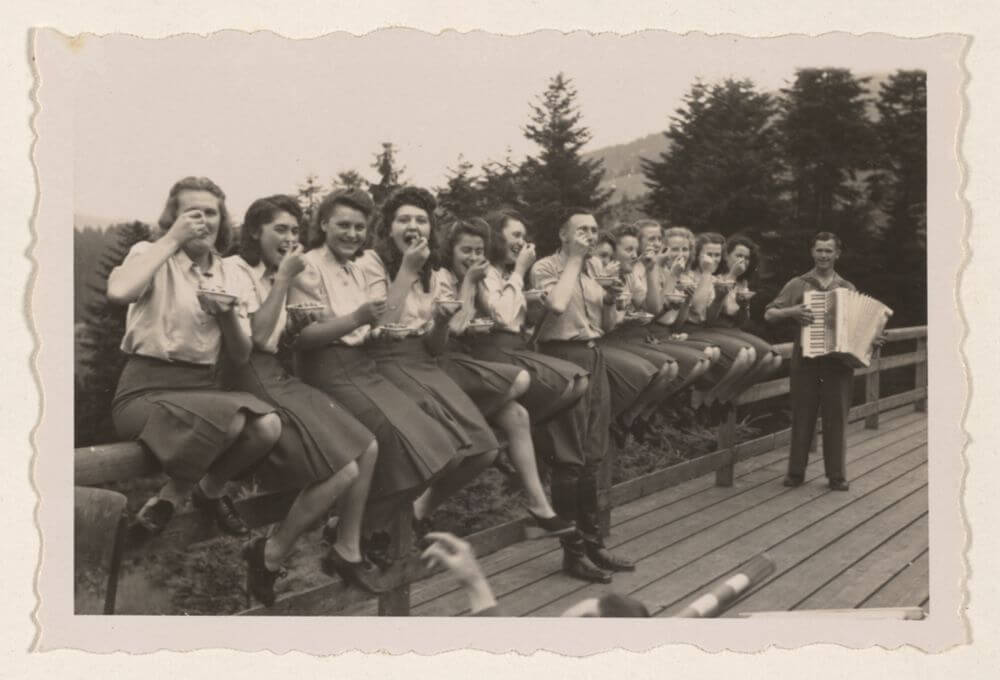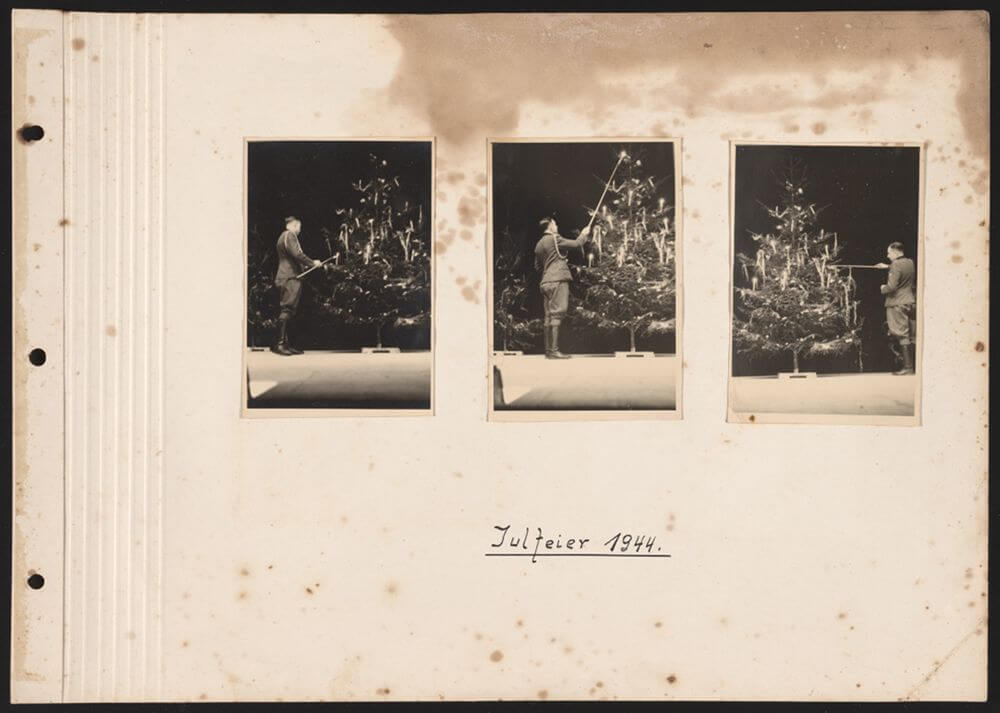Women’s auxiliaries and SS officers enjoy music not fare from the Barracks of Auschwitz-Birkenau. Courtesy of U.S. Holocaust Memorial Museum
In 2006, Rebecca Erbelding, an archivist at the United States Holocaust Memorial Museum, was paging through a newly submitted photo album from an anonymous donor. The album contained images from Auschwitz, but they were not what she expected.
“I was looking for things that I recognized,” said Erbelding, now the historian for the secondary education team at the museum. “I was looking for trains and prisoners and didn’t see any of that.”
Instead she saw officers picnicking, hunting and celebrating Christmas. The third time she sorted through the dusty pile of pages — many with water damage — she recognized a figure in an SS uniform, laughing, his hand tucked into his jacket. It was Josef Mengele. The image was the first photographic evidence placing the doctor at the camp where he committed his horrific experiments on prisoners.
Erbelding showed the pages to Judy Cohen, the director of the museum’s photographic collection. By the end of the day they had identified six or seven members of Nazi leadership.
The album, first owned by Karl Höcker, adjutant to Auschwitz’s third commandant Richard Baer, captures Nazi command and camp staff in their leisure. The photos were not limited to the top brass. A series of photographs show young women auxiliaries sitting on the deck of the Solahütte, a riverside chalet about 20 miles from the barracks. A handwritten caption reads “Here there are blueberries,” and shows the women smiling and sampling the fruit while a man plays the accordion.
As history, the album was invaluable. There are very few photographs of Auschwitz prior to the camp’s evacuation, and Höcker’s collection contains some of the last images of the camp before the arrival of the Red Army on Jan. 27, 1945. But on receiving the Höcker album, museum staff debated whether to display the images, concerned that doing so might elevate Nazis or that these happy snapshots of the camp personnel committing no crimes might even fuel Holocaust denial.

In the end, the decision was made to share the photographs with the press, advancing the museum’s mission beyond victims to a consideration of the perpetrators and their experience.
Moisés Kaufman, co-founder of Tectonic Theater Project, known for documentary dramas like The Laramie Project, read about the photos in the front page of The New York Times in September of 2007, with a banner image of Höcker resting on the porch of Sola hut.
Kaufman, whose father survived the Shoah as a child in Romania, had long wanted to do a piece about the Holocaust, but struggled with how to tell a new story about it.
“The images of these people just having a perfectly lovely day, when, outside of the frame, 1.1 million people are being killed, really struck me,” said Kaufman, whose play, Here There Are Blueberries, made its New York debut at New York Theatre Workshop April 17. The photos posed big questions, like how could one enjoy blueberries outside of Auschwitz and, more searchingly, what is the difference between culpability, complicity and complacency?
When Kaufman and his co-writer Amanda Gronich interviewed Erbelding and her colleagues about receiving the photos, they discovered their archival process had the makings of a detective story they could recreate onstage. The play begins with a primer on the rise of Leica cameras and reveals how the democratized habit of photography paved the way for the images we see in the show — photos that Gronich says behave like scene partners for the cast of 10.
The actors use dialogue taken from the playwrights’ interview transcripts; the Nazis only ever appear in pictures. Erbelding is the central character in the play, working with her colleagues to piece together the faces she recognizes and, by the end, undermining claims that any of the people pictured was truly ignorant of the horrors they contributed to. (Another album featured in the play, called the Lili Jacob album after the survivor who discovered it, testifies to this; its images recording the selection of Hungarian Jews for extermination, were taken by the same photographer of many of the images in the Höcker album.)

Gronich and Kaufman also interviewed descendants of people in the photographs, including Peter Wirths, the son of SS doctor Eduard Wirths, and Rainer Höss, the grandson of Auschwitz’s founding commandant Rudolf Höss. A number of the photos in the play show Höss’ garden and swimming pool, recreated in Oscar-winning film The Zone of Interest.
But while that film focuses on one family, Blueberries takes a broader view, Kaufman says. It doesn’t focus exclusively on Höss, whose crimes are unambiguous, but also depicts the young women secretaries who, while maybe not culpable, were nonetheless complicit. Looking into the record, Gronich and Kaufman found that this complicity was not entered into with reluctance — many later recalled their tenure at Auschwitz as the best time of their lives.
Kaufman, who has directed the play in La Jolla and Washington, D.C. says working on it is “traumatizing,” but that he is energized by the idea that the carousing pictured in the private album is something the Nazis would never want the world to see.

“How we tell history is based in no small part on the evidence that history leaves behind,” said Gronich. “Becky’s making this call to action for all of us — what’s in your closet, what’s in your basement, what’s in your attic? The responsibility we all have to bring those artifacts out, let historians and all of us share in the telling of history.”
Erbelding is still discovering details in the photos she first saw 17 years ago, which the play’s production team project onto the set, blown up from their original 2 by 1 inch dimensions. At the final dress rehearsal at New York Theatre Workshop, she noticed, for the first time, Höcker lurking in the background of one of the photos of officers relaxing on lounge chairs.
“One of the reasons I keep going back is I keep learning every time I see the play,” she said.
Tectonic Theater Project’s Here There Are Blueberries is now playing at New York Theatre Workshop. Tickets and more information can be found here.

I hope you appreciated this article. Before you go, I’d like to ask you to please support the Forward’s award-winning journalism this Passover.
In this age of misinformation, our work is needed like never before. We report on the news that matters most to American Jews, driven by truth, not ideology.
At a time when newsrooms are closing or cutting back, the Forward has removed its paywall. That means for the first time in our 126-year history, Forward journalism is free to everyone, everywhere. With an ongoing war, rising antisemitism, and a flood of disinformation that may affect the upcoming election, we believe that free and open access to Jewish journalism is imperative.
Readers like you make it all possible. Right now, we’re in the middle of our Passover Pledge Drive and we still need 300 people to step up and make a gift to sustain our trustworthy, independent journalism.
Make a gift of any size and become a Forward member today. You’ll support our mission to tell the American Jewish story fully and fairly.
— Rachel Fishman Feddersen, Publisher and CEO
Join our mission to tell the Jewish story fully and fairly.
Only 300 more gifts needed by April 30















